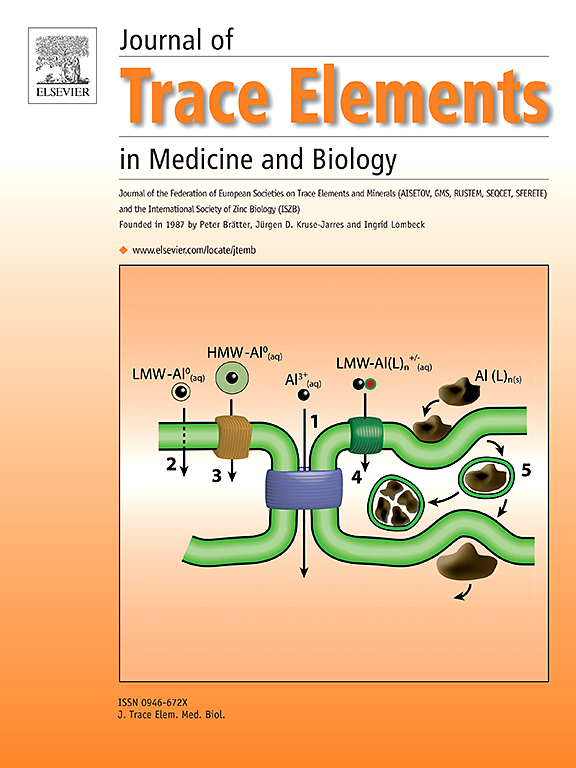Cellular activity of the cytosolic selenoprotein thioredoxin reductase 1 (TXNRD1) is modulated by copper and zinc levels in the cell culture medium
IF 3.6
3区 医学
Q2 BIOCHEMISTRY & MOLECULAR BIOLOGY
Journal of Trace Elements in Medicine and Biology
Pub Date : 2025-02-17
DOI:10.1016/j.jtemb.2025.127624
引用次数: 0
Abstract
Background
Selenium (Se), Copper (Cu) and Zinc (Zn) are essential trace elements, required for several cellular functions, showcasing toxicity in either insufficient or excessive concentrations. The selenoprotein thioredoxin reductase 1 (TXNRD1) is directly affected by Se availability and here we hypothesized that it may also be affected by high Cu and Zn concentrations.
Methods and results
Using an optimized protocol for the highly selective TXNRD1 activity probe, RX1, we discovered a direct inhibitory effect of Zn on the intracellular TXNRD1 activity, using two different commonly used human cancer cell lines, A549 lung carcinoma and HeLa cervical carcinoma cells. Subsequently, after initial inhibition by Zn, the TXNRD1 activity recovered in both cell lines, in HeLa cells concomitantly with activation of the redox regulatory transcription factor NRF2. High extracellular Cu concentrations did not induce an immediate decrease of intracellular TXNRD1 activity, but decreased its activity upon long-term exposure. While the expression levels of TXNRD1 did not change upon long-term Cu exposure, the selenoprotein glutathione peroxidase 1 (GPX1), that is more dependent upon selenocysteine incorporation, was downregulated, suggesting that higher Cu exposure generally impaired selenoprotein synthesis.
Conclusion
Our findings support the importance of understanding trace element exposure and availability in basic research, especially in redox biology research, as well as considering Cu and Zn as potential modulators of the cellular capacity of the thioredoxin system and other selenoproteins.
胞质硒蛋白硫氧还蛋白还原酶1 (TXNRD1)的细胞活性受细胞培养基中铜和锌水平的调节
硒(Se)、铜(Cu)和锌(Zn)是几种细胞功能所必需的微量元素,浓度不足或过高都会显示出毒性。硒蛋白硫氧还蛋白还原酶1 (TXNRD1)直接受到硒可利用性的影响,这里我们假设它也可能受到高Cu和Zn浓度的影响。方法与结果采用高选择性TXNRD1活性探针RX1优化方案,以两种常用的人类癌细胞系A549肺癌细胞和HeLa宫颈癌细胞为实验对象,发现锌对细胞内TXNRD1活性有直接抑制作用。随后,在锌的初始抑制后,两种细胞系的TXNRD1活性恢复,在HeLa细胞中,TXNRD1活性同时激活氧化还原调节转录因子NRF2。高细胞外Cu浓度不会立即降低细胞内TXNRD1活性,但长期暴露会降低其活性。虽然TXNRD1的表达水平在长期铜暴露后没有变化,但硒蛋白谷胱甘肽过氧化物酶1 (GPX1)的表达水平下调,GPX1更依赖于硒半胱氨酸的掺入,这表明高铜暴露通常会损害硒蛋白的合成。结论我们的研究结果支持了解微量元素暴露和可利用性在基础研究,特别是氧化还原生物学研究中的重要性,以及考虑Cu和Zn是硫氧还蛋白系统和其他硒蛋白的细胞容量的潜在调节剂。
本文章由计算机程序翻译,如有差异,请以英文原文为准。
求助全文
约1分钟内获得全文
求助全文
来源期刊
CiteScore
6.60
自引率
2.90%
发文量
202
审稿时长
85 days
期刊介绍:
The journal provides the reader with a thorough description of theoretical and applied aspects of trace elements in medicine and biology and is devoted to the advancement of scientific knowledge about trace elements and trace element species. Trace elements play essential roles in the maintenance of physiological processes. During the last decades there has been a great deal of scientific investigation about the function and binding of trace elements. The Journal of Trace Elements in Medicine and Biology focuses on the description and dissemination of scientific results concerning the role of trace elements with respect to their mode of action in health and disease and nutritional importance. Progress in the knowledge of the biological role of trace elements depends, however, on advances in trace elements chemistry. Thus the Journal of Trace Elements in Medicine and Biology will include only those papers that base their results on proven analytical methods.
Also, we only publish those articles in which the quality assurance regarding the execution of experiments and achievement of results is guaranteed.

 求助内容:
求助内容: 应助结果提醒方式:
应助结果提醒方式:


